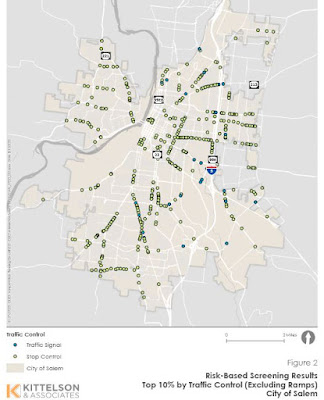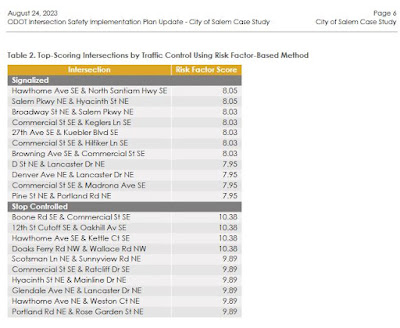In the agenda packet for the next Budget Committee meeting on May 1st is reference to a new intersection safety study the City had not mentioned publicly before.
 |
| These are our busy streets |
It's hard to see, however, what it accomplishes.
 |
| A new safety study |
At a glance from here, it looks like a restatement of the obvious: Streets fast or busy (or both) are dangerous!
 |
| Summary |
It shows a big intersection on Lancaster and points to turning conflicts and weaving/merging movements as if discovering they were dangerous was some novel insight.
 |
| Weaving/merging and turning conflicts are known! |
The list and map of worst intersections (at top) is simply a map of our busy streets.
 |
| Worst intersections in this analysis |
It's just not clear at all what this adds to what we already know. It looks redundant. And it masks the system problems of our autoism as just a minor series of spot problems.
 |
| There are gaps and assumptions in the data sources |
It also drapes the project in a pseudo-scientific false-precision. If you go through the methodological discussion, you find moments with assumptions and gaps. The uncertainty in the underlying inputs suggests that carrying a risk factor score out to 0.01 is unwarranted precision, and any scoring should instead be bucketed in tiers. The false precision is especially annoying when it is used to quantify and "validate" something advocates and ordinary people have known qualitatively and subjectively, and yelled about for years and decades.
See in particular:
- "Like Weather Forecasting, our Traffic Forecasting Needs Error Bars" (2015)
- "Study on Traffic Forecasting Urges Embrace of Uncertainty" (2020)
- "On Forecasting and Uncertainty" (2020)
This might be a convenient moment to mention a forthcoming book that looks interesting.
 |
| via the former Twitter |
Killed by a Traffic Engineer: Shattering the Delusion that Science Underlies our Transportation System has been blurbed by Jeff Speck, Angie Schmidt, and Donald Shoup. Though Charles Marohn isn't on that list, perhaps related to the recent licensing litigation, as the Guilds of Professional Engineers do not take kindly to critique, the book sure looks consistent with the old "Conversation with an Engineer" bit. It also looks consistent with some of the notes here on the pseudo-science of traffic modeling and forecasting (see bullets above).
The publisher says
Thoroughly researched and compellingly written, Killed by a Traffic Engineer shows how traffic engineering “research” is outdated and unexamined (at its best) and often steered by an industry and culture considering only how to get from point A to B the fastest way possible, to the detriment of safety, quality of life, equality, and planetary health. Marshall examines our need for speed and how traffic engineers disconnected it from safety, the focus on capacity and how it influences design, blaming human error, relying on faulty data, how liability drives reporting, measuring road safety outcomes, and the education (and reeducation) of traffic engineers.
Killed by an Engineer comes out in June.
 |
| Part of breakdowns by NA and Ward |
Also in the Budget Committee packet for May 1st are breakdowns of the CIP projects by Neighborhood Association and by Council Ward.
 |
| Highland and Sunnyslope have the least |
The two lowest are Sunnyslope, a relatively prosperous area, and Highland, not so prosperous. It did not appear there was a meaningful bias against poorer neighborhoods, but maybe someone on the Committee will take a closer look and find something.
The Budget Committee meets Wednesday, May 1st at 6pm.


2 comments:
Another flaw with this study, which maybe we'll come back to in more detail, is that is used "posted speed" as an input, and not any measured speed. So it relies on a theoretical, prescriptive value, and not on a descriptive value like 50th percentile or 85th percentile speed.
It would be more useful to tie road characteristics to actual speeding!
Also, there's an ODOT list of high crash intersections and it would have been useful to identify existing high crash intersections that are not flagged in this risk assessment - do they correlate or are there patterns of misalignment?
Post a Comment